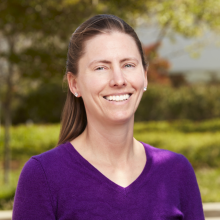-
Title
Electrical Engineer -
Email
poyneer1@llnl.gov -
Phone
(925) 423-3360 -
Organization
ENG-CED-COMPUTATIONAL ENGINEERING
Dr. Lisa Poyneer is an internationally-recognized expert in adaptive optics (AO) and a Distinguished Member of the Technical Staff at Lawrence Livermore. She led the testing and verification of the AO system of the Gemini Planet Imager, which at its deployment in 2014 was world's most powerful astronomical AO instrument.
Lisa developed key new technologies for GPI, including Fourier Transform wavefront reconstruction and the spatially-filtered wavefront sensor. She has since worked on adaptive optics projects in lasers, microscopy, space security and x-ray optics. Her current research centers on the design and testing of predictive control algorithms for high-speed AO.
Dr. Poyneer has lectured extensively about AO to a wide range of audiences, from graduate students to middle-schoolers. Her "Science on Saturday" lecture, "Distant Worlds: Images of Other Solar Systems," done with Dr. Bruce Macintosh, can be viewed online.
Lisa served as the Scientific Editor of the Laboratory’s Science & Technology Review magazine (April/May 2012–March 2013 issues). Since October 2023, she has been the Deputy Director of LLNL’s Laboratory Directed Research & Development (LDRD) Program Office.
Lisa joined the Laboratory in 2001 after a Rhodes Scholarship at the University of Oxford. She has S.B. and M.Eng. degrees from the Massachusetts Institute of Technology and a Ph.D. from University of California, Davis, all in the areas of Electrical Engineering and Computer Science.
Ph.D., Electrical and Computer Engineering, University of California, Davis, CA, 2007 (concurrently with employment at LLNL)
B.A., Modern History, University of Oxford (Worcester College), 2001
M.Eng., Electrical Engineering and Computer Science, Massachusetts Institute of Technology, 1999
S.B., Computer Science and Engineering, Massachusetts Institute of Technology, 1998
L. A. Poyneer, et al., "Laboratory demonstration of the prediction of wind-blown turbulence by adaptive optics at 8kHz with use of LQG control,” Appl. Opt. 62, 1871-1885 (2023).
L. A. Poyneer, et al., "X-ray metrology and performance of a 45-cm long x-ray deformable mirror, " Review of Scientific Instruments 87, 052003 (2016).
L. A. Poyneer, et al., "Performance of the Gemini Planet Imager's adaptive optics system, " Appl. Opt. 55, 323-340 (2016).
B. Macintosh, et al., "Discovery and spectroscopy of the young jovian planet 51 Eri b with the Gemini Planet
Imager," Science 350, 64-67 (2015).
B. Macintosh, et al., “First light of the Gemini Planet Imager,” Proceedings of the National Academy of Sciences (2014).
L. A. Poyneer, et al., “Sub-nanometer flattening of 45 cm long, 45 actuator x-ray deformable mirror,” Appl. Opt. 53, 3404– 3414 (2014).
D. Savransky, et al. “Computer vision applications for coronagraphic optical alignment and image processing,” Appl. Opt. 52, 3394–3403 (2013).
L. A. Poyneer and J.-P. Veran, “Kalman filtering to suppress spurious signals in adaptive optics control,” J. Opt. Soc. Am. A 27, A223–A234 (2010).
L. A. Poyneer, M. A. van Dam, and J.-P. Veran, “Experimental verification of the frozen flow atmo- spheric turbulence assumption with use of astronomical adaptive optics telemetry,” J. Opt. Soc. Am. A 26, 833–846 (2009).
L. A. Poyneer and J.-P. Veran, “Predictive wavefront control for adaptive optics with arbitrary control loop delays,” J. Opt. Soc. Am. A 25, 1486–1496 (2008).
L. A. Poyneer, et al., “Laboratory demonstration of accurate and efficient nanometer-level wavefront control for extreme adaptive optics,” Appl. Opt. 47, 1317–1326 (2008).
L. A. Poyneer, B. A. Macintosh, and J.-P. Veran, “Fourier transform wavefront control with adaptive prediction of the atmosphere,” J. Opt. Soc. Am. A 24, 2645–2660 (2007).
J. W. Evans, et al., “Demonstrating sub-nm closed loop MEMS flattening,” Opt. Exp. 14, 5558–5570 (2006).
L. A. Poyneer and B. A. Macintosh, “Optimal Fourier Control performance and speckle behavior in high-contrast imaging with adaptive optics,” Opt. Exp. 14, 7499–7514 (2006).
L. A. Poyneer, et al. “Experimental demonstration of phase correction with a 32 x 32 microelectricalmechanical systems mirror and a spatially filtered wavefront sensor,” Opt. Lett. 31, 293–295 (2006).
L. A. Poyneer and J.-P. Veran, “Optimal modal Fourier transform wave-front control,” J. Opt. Soc. Am. A 22, 1515–1526 (2005).
L. A. Poyneer and B. Macintosh, “Adaptive optics: Spatially filtered wave-front sensor for high-order adaptive optics,” Optics & Photonics News 15, 15 (2004).
L. A. Poyneer and B. Macintosh, “Spatially filtered wave-front sensor for high-order adaptive optics,” J. Opt. Soc. Am. A 21, 810–819 (2004).
L. A. Poyneer, “Scene-based Shack-Hartmann wave-front sensing: analysis and simulation,” Appl. Opt. 42, 5807–5815 (2003).
L. A. Poyneer, et al., “Experimental validation of Fourier transform wave-front reconstruction at the Palomar Observatory,” Opt. Lett. 28, 798–800 (2003).
L. A. Poyneer, D. T. Gavel, and J. M. Brase, “Fast wave-front reconstruction in large adaptive optics systems with use of the Fourier transform,” J. Opt. Soc. Am. A 19, 2100–2111 (2002).
2023 LLNL Director’s Science and Technology Award for ``A 15-Year Effort to Validate Adap- tive Optics Predictive Wavefront Control''.
Participant, National Academies Frontiers of Engineering Symposium, September 2015.
Session organizer and speaker, ``Imaging the Unseen: Advanced Adaptive Optics Enabling Scientific Discovery,'' at the AAAS Annual Meeting, Feb 2015.
Participant, National Academies Keck Futures Initiative, “Seeing the Future with Imaging Science,” November 2010.
2010 Inductee to the Alameda County Women's Hall of Fame.
Top five finalist for the 2008 Council of Graduate Schools/Proquest UMI Distinguished Dissertation Award in Mathematics, Physical Sciences and Engineering (nationwide contest for best doctoral dissertation).
2008 Marr Prize for the most distinguished doctoral dissertation at UC Davis.
2008 Munir Award for the best doctoral dissertation in the UC Davis College of Engineering.
2008 Jain Prize for the best doctoral dissertation in the UC Davis Electrical and Computer Engineering Department.
Paper, “Spatially filtered wave-front sensor for high-order adaptive optics,” was selected for OSA's Optics and Photonics News “Best in 2004” issue as one of the 31 best optics papers of the year.
1999 Rhodes Scholar.
1998 Henry Ford II Scholar award for being the senior with the highest level of academic excellence in MIT’s School of Engineering.
1998 Association of MIT Alumnae Award for being the female undergraduate with the highest level of academic and professional excellence at MIT.


